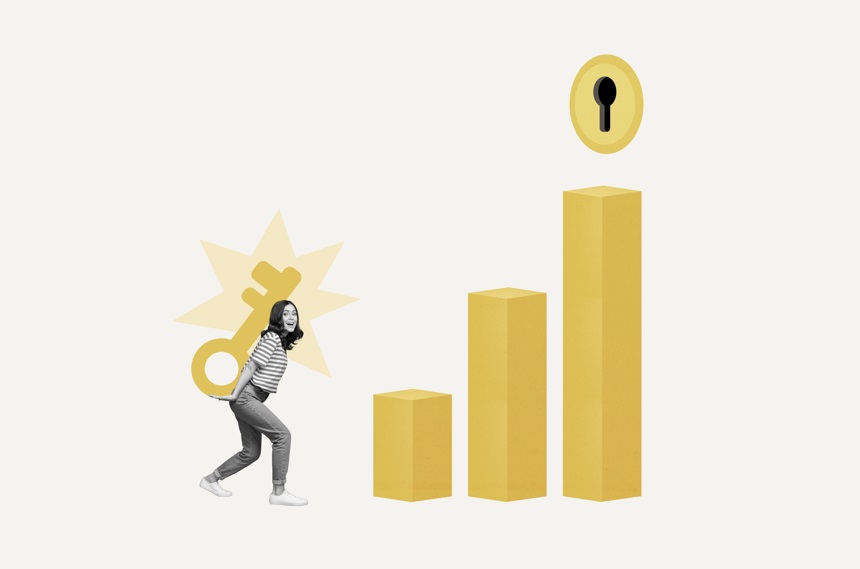By Peter Lorange
In uncertain times, strategic leadership is crucial for navigating growth. Dr Peter Lorange, Honorary President of IMD, explores how executives can harness volatility to drive success. This blueprint proposes developing innovative programmes for leadership amidst economic turbulence and emerging opportunities.
Introduction
These are, without a doubt, uncertain times, and most leaders are, inevitably and predictably, becoming more concerned about the future. We observe throughout the world more apprehension about economic slowdowns. Yet, as in most such unstable or challenging cycles, there are several potential opportunities that may open up, as is clearly the case now in interesting new, sometimes even unexpected, directions and markets. Plus, valuations of projects and take over consolidates all are becoming more “reasonable”, and growth multiples are generally coming down. EBITA / cash multiples seem to be going up. In these unclear cycle periods, focus tends to swing relatively more towards the bottom line, with payback-related issues becoming more and more central. These challenges, and others, call for the development of a cutting-edge executive programme that addresses these issues, to be discussed in the following sections.
Turbulence
Volatility might seem to be the new normal today, and inflation looks to be oscillating around a higher average.
Volatility might seem to be “the new normal” today, and inflation looks to be oscillating around a higher average. The same appears to be the case when it comes to interest rates. However, predicting the future of the economy might be harder than before. Exchange rates for currencies could represent a particularly difficult variable to forecast! And, since the overall uncertainty tends to be higher, the business risk of failure also increases. Turbulence is a different beast from before. We used to live in a world heavily dominated by the US and the dollar. Now we are seeing several political blocs, such as those countries that are part of G9, the BRIC, etc., growing in voice and weight. We are observing an rise in nationalism, where actions by governments or states may increasingly become more critical from “free market” trading. The global financial crisis in 2009 seems to have had a catalytic effect when it comes to leading up these changes.
There are several other factors that now might imply greater risk:
- Higher governmental regulations, including “new” taxes. Also, moves from the government sector may be less predictable than before.
- Political value chain disruptions, including wars.
- Customer shifts:
- Political: more extreme, nationalistic
- Environmental: emission, climate
- Behavioural and attitudinal
- Economical: the increasing circular economy (recirculating raw materials, repairing)
- Security; breaches and hacking in cyberspace; cryptocurrency; fraud, …
Also, there may be internal factors in our own organisations that might be linked to increased turbulence:
- Lowering of employee morale, even resignations of central executives.
- Increased fatigue syndrome, fatigue, burnout, chronic fatigue.
- Scandals and whistleblowing, often entailing lessening of own reputation.
- Sloppiness and unacceptable performance with inefficiency and higher costs.
So, why is growth so key?

Latching on to emerging business, often in new markets, typically allows firms to better “protect” their ongoing performance. Growth thus might strengthen the bottom line. But it nevertheless is still a matter of achieving both top-line and bottom-line performance, as research by Chakaravarthy and Lorange, 2007, found. If one of these dimensions fails, (for instance, lessening of growth), then the other dimension will also tend to fail, with lowering of profits as the result.
Ample access to energy is typically critical for growth. There may be a paradox here when it comes to economies such as Norway. While global prices for oil and gas are increasing, not least due to wars, with the tendency for a greater demand from industry (chemicals, electricity generation, …), prices of energy from other types of sources (solar, wind, …) do not seem to diminish. To develop such new infrastructure still appears to be expensive, although prices for this generally drop substantially. And public behaviour shows that consumers are largely not attracted to the nuclear power option. Political behaviour seems to confirm this.
Growth may also come about through typically fairly small “add-ons”, such as product improvements, value chain extensions, service contracts added to product distribution, software applications, etc. Being free to test out new markets without restrictions on mobility (e.g., Norway’s new “exit” tax) may be key.
Finally, growth can come about, in the longer term at least, through shifts to factors of the so-called circular economy. A Norwegian owner of sports clothing is now, for instance, focusing on making use of more durable raw materials for its sporting goods brands, so as to allow for self-repair by consumers. And new tape and glue from the Hamburg-based firm tesa allows for an easier recirculation of scrap vehicles, outdated mobile phones, and old electronics in general. Such products, increasingly perceived by consumers as desirable, although more expensive, may be expected to grow, both in number and availability, at least in the longer term.
Raw materials
It seems to be increasingly important to identify large, robust deposits of mining ore and other core materials. Major economic powers such as the US, Russia, China, and the EU appear particularly active. Rare earths may be a particularly critical raw material, in light of their uses in modern, technologically advanced technologies such as batteries, computer components, medical scanning devices, mobile phones, and so on.
How can crises be turned into opportunities?
A fundamental truism is that one should always try to avoid getting into crises. But, if a crisis situation should nevertheless emerge, then, well, just take advantage of it!
Growth can strengthen the bottom line, but it requires achieving both top-line and bottom-line performance.
Planning different scenarios is not just nice to have, but essential. By being more ready in crisis cases, responses and reactions might more readily become good counteractions, even counter-counteractions, when the process evolves through certain counteractions to be taken. It seems key to “see”, and not just collect, the signals more clearly, even the smallest ones, from emerging adverse developments. True data collection, analysis, and management are not what they used to be. We are talking here about honed-in, fine-tuned, highly perceptive signal observation.
Data analysts, to borrow the concept from the phrase from art “art for art’s sake” (“l’art pour l’art”) are now in the era of “data for data’s sake”, and even the definition and nature of “data” is changing. As coined in the nineteenth century about art, we can now support the idea that data for data’s sake shows how data, even in its almost invisible form – minute data, weak signals – is a value independent of its subject matter, or of any social, political, or ethical significance. This understanding and mastery seems to be particularly critical in rapidly changing markets, such as, say, in shipping. It may be especially important here to prepare to rapidly exit from positions in such a market, and not be lulled into “wishful” thinking and / or to be seduced into unrealistic alternative scenarios that may, in the end, cause costly delays or diversions.
Organisational culture with more non-linear thinking

A firm’s organisational culture is, of course, central when it comes to taking advantage of opportunities that might stem from crises. Firms may have to modify their corporate culture to be better prepared for this. The solution might be to instil a more “out of the box” approach, by encouraging so-called non-linear thinking (Thomas; Rose and Schulman; Zollo et al.).
Non-linear thinking is en vogue these days. But what is it actually? While there seem to be many different definitions, what seems essential is that non-linear thinking implies thinking differently from so-called linear thinkers who tend to build thoughts, literally in steps, order and with structure. Non-linear thinking incorporates a more open-minded orientation to the world, by having more of a “can-do”, entrepreneurial motivation, by being comfortable with a long-term time horizon. Finally, by being able to communicate their often radical, “out of the box” solutions with passion and enthusiasm. Order and logic is not always as important in non-linear thinking, where spontaneity, impulses, signals, reversal of steps, even circular or spiky reflection can bring about higher levels of creativity and innovation.
Jan Thomas (2020) states that a non-linear thinker might be seen as a detective, along the following seven dimensions:
- Be attracted to challenges and the unknown.
- Find the big picture by looking for similar as well as dissimilar patterns.
- Ask questions – many seemingly unrelated – to deepen the back story.
- Use visual boards and / or screens, to better be able to “see” connections and relationships (poster stickers!).
- Identify several possibilities.
- Synthesise options.
- Choose the best option for a solution.
(Source: Thomas, p. 20).
While some of these “steps” might appear self-evident, they nevertheless reflect the non-linear thinking processes that co-creation teams typically go through. They are indeed detectives!
These seven thinking steps might certainly reflect entrepreneurial passion. Zollo et al. have undertaken important research that confirms that non-linear thinking and entrepreneurship go well together, in sharp contrast to linear thinkers with more conventional “solutions”. So, the bottom line is that co-creation, non-linear thinking, and entrepreneurship are a nice match.
Weak signals
Signals, though, may often be difficult to detect. Here are some areas where so-called weak signals (some from Tyrie, 2024) may be looked for. In particular, let’s consider:
- The rise of quantum computing
- Sustainability; circular economy
- “Digital” remote work
- AI
- Blockchain
- Psychological or emotional reactions of leaders, teams, employees, clients, partners…
- Behaviour, purchase patterns; customers, clients, suppliers, etc.
- Supply chains, distribution
- Nature, climate, environment; shifts, patterns

Ansoff (1975) first suggested that firms might set up internal organisations to look for weak signals, consistent with the development of scenarios discussed in the previous paragraph.
Lorange (2005) describes how “weak” signals might be detected for evolution trends in shipping markets. When it came to so-called offshore platform supply ships (PSV) markets, the ratio of actual PSV ships in operation relative to such ship new buildings on order was monitored. A significant increase in new building orders might be seen as a “weak” signal to sell existing PSV ships from one’s fleet and / or attempt to arrange for long-term charters for one’s ships. A falling market might be expected!
Crises may also provide impetus for easier ways to implement changes that might be more difficult to pursue during more normal times:
- Organisations: Employees may now become more opento the need for, say, efficiency improvements, new waysof working.
- New markets: Leaders and their staffs may perhaps now more fundamentally “open their eyes” and realise that new markets are now even more important, in contrastto “clinging” to old, traditional markets.
- Innovations: These may now be easier to implement. To resist change in one’s value chain, for instance, may presently be riskier. The “why bother to change?” attitude may become less viable. These may not necessarily imply huge new steps. Non-conventional broadening of one’s value chain may be fundamental, for example, by adding service offerings, lessening breakdowns in more traditional, well-established cultures.
In other words, in times of crises, it isn’t about “wiping the board clean”. Recovery, realignment, refocus, reboot, revise, “re-anything”, is learning how to function around all of the “scars and open wounds” and move on, move forward. Without getting into theories of business cycles, yet as a deep believer in the concept of business cycles – that they exist and that leaders need to watch for them, master them and use them – the point to underline here is that change can often be easier to introduce or implement in times of crises.
Invest, invest, invest
It goes without saying that, while stability tends to equalise investment opportunities for all, turbulent times may unearth exceptional investment opportunities for “smart” investors. It might perhaps sound counterintuitive for some that one would want to invest more in such “tougher” times and, conversely, to be rather “picky” during more stable times. Yet, this mode of “countercyclical” investing seems to be significant for high value creation.
This assumes smartness, insightfulness, and willingness to live with / take risk. The ability to identify key, viable markets might be particularly important when it comes to this. A new Norwegian tax regulation regarding exiting from Norway (March 2024) seems to be dysfunctional when it comes to this. For example, to exit from Norway to Switzerland may perhaps be more a matter of better “seeing” good investment opportunities being based in this central, more global, market, rather than being primarily motivated by tax-related considerations. Many have said that to be a successful investor means combining knowledge, discipline, and having a long-term perspective. A splash of good luck is also essential, of course. Avoid impulsiveness and emotions!

Conclusions – why an executive programme?
We need future leaders who are simultaneously creative and highly observant, all the while being daring.
Why, then, may we need a new executive programme on the importance of growing, particularly when things are turbulent? We asserted that turbulence may actually be welcomed by firms that are prepared to take advantage of this. Significant profit increases might result. We have suggested three factors that, above all, might help corporations to be prepared to opportunistically cope with turbulence: change one’s corporate culture to be more supportive of non-linear thinking, strengthen one’s ability to detect “weak” signals, and be ready to invest aggressively. We need future leaders who are simultaneously creative and highly observant, all the while being daring. This turbulence-savvy leadership needs to be stimulated, taught and trained in ways that are probably quite different from before, and this is most likely not the same type of MBA or leadership programme as that available now or just a few years ago. Leading business schools and other providers of high-quality executive education should rise to the challenge of offering a programme, a sort of “turbulence course”, on these issues. The question will remain: do we need next-gen turbulence training year after year? Is this the new executive education direction? Is turbulence training more than future readiness?




 Peter Lorange
Peter Lorange































